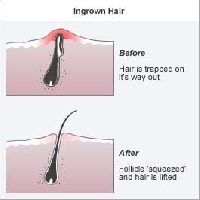
Getting rid of ingrown hairs is a challenge for people with this skin condition
An ingrown hair occurs when the pointed tip of the strand grows sideways or curls back into the skin. This is a common occurrence. It is considered a skin condition. Normally, ingrown hairs do not crop up until after puberty.
This occurs in areas where coarse hairs are usually found, including the neck and the beard on men, and the bikini area in females. Those who naturally have coarse, thick hair are more likely to experience this problem.
Getting rid of ingrown hairs can be challenging. You may see a bump and a dark area which is the underlying hair. Areas frequently shaved — necks on men, legs, the pubic area on women — may sport numerous pink or red bumps that pop up around follicles.
For the most part, this problem is complication-free although it may be an aesthetic issue. However, in some cases it leads to skin discoloration, which is medically referred to as post-inflammatory hyper-pigmentation, or to scarring, an infection and, rarely, to keloid scar formation.
~
A keloid is a scar that doesn’t heal properly. It becomes ‘heaped up,’ rising above the skin. It is haphazardly shaped and gets increasingly bigger.
A person may experience razor bumps (pseudofolliculitis barbae), which is a type of ingrown follicle. This problems flares up every time a person shaves.
When experiencing ingrown follicles the individual may notice tenderness and itching at the site. Sometimes pus is present. The condition gets worse as hair grows backwards, into the skin’s surface. Acne whitehead (milia) may be present.
After shaving, a person may experience a painful acne-like flare-up. Pustules and sometimes abscesses form if infection is present due to skin bacteria. The area may appear red because tiny blood vessels in the upper layer of skin have become dilated.
Getting rid of them …
Do not irritate the hair. Gently exfoliate the area with a warm washcloth or a textured skin-cleaning mitt. Do not shave until the irritation and redness have passed. Do not try to remove the follicles because this can lead to scarring and infection. However, if you are determined to get rid of it you can attempt to lift the follicles using a toothpick. If it’s resistant, stop and do not proceed. A physician can remove the follicle.
If you do succeed in removing the follicle, do not take a hot bath or shower for several hours. Hot water can irritate pores, resulting in discomfort and bumps. Following removal, do not wear tight clothes because this irritates the area.
Treatments include applying topical antibiotics, using chemical depilatories, medical removal, topical creams, hair removal laser and electrolysis. Using a combination of these techniques is often advised.
Products such as Neet, a chemical depilatory, will loosen the hair structure leading to dulled tips of hair at the opening of the follicle. Depilatories can irritate skin. Put hydrocortisone cream on the site to relieve irritation.
Oral and topical antibiotics are used for severe cases. They treat secondary infections and limit growth of skin bacteria. Retin A (tretinoin) creams lessens skin plugging because it thinks out the epidermis, reducing dead skin cell build-up and hair embedding. Topical creams are applied to get rid of inflammation.
Some sufferers opt for laser removal. This permanently decreases the amount of hair. This technique is used primarily on dark hair. There is the risk of skin discoloration occurring post-laser treatment.
Electrolysis allows a person to remove hair forever and never again have to worry about ingrown ones. The follicles are destroyed. This is a long, drawn-out process, requiring several treatments.

